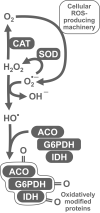Chili-supplemented food decreases glutathione- S-transferase activity in Drosophila melanogaster females without a change in other parameters of antioxidant system
- PMID: 36200601
- PMCID: PMC9553170
- DOI: 10.1080/13510002.2022.2123884
Chili-supplemented food decreases glutathione- S-transferase activity in Drosophila melanogaster females without a change in other parameters of antioxidant system
Abstract
Objectives: Many plant-derived anti-aging preparations influence antioxidant defense system. Consumption of food supplemented with chili pepper powder was found to extend lifespan in the fruit fly, Drosophila melanogaster. The present study aimed to test a connection between life-extending effect of chili powder and antioxidant defense system of D. melanogaster.
Methods: Flies were reared for 15 days in the mortality cages on food with 0% (control), 0.04%, 0.12%, 0.4%, or 3% chili powder. Antioxidant and related enzymes, as well as oxidative stress indices were measured.
Results: Female flies that consumed chili-supplemented food had a 40-60% lower glutathione-S-transferase (GST) activity as compared with the control cohort. Activity of superoxide dismutase (SOD) was about 37% higher in males that consumed food with 3% chili powder in comparison with the control cohort. Many of the parameters studied were sex-dependent.
Conclusions: Consumption of chili-supplemented food extends lifespan in fruit fly cohorts in a concentration- and gender-dependent manner. However, this extension is not mediated by a strengthening of antioxidant defenses. Consumption of chili-supplemented food does not change the specific relationship between antioxidant and related enzymes in D. melanogaster, and does not change the linkage of the activities of these enzymes to fly gender.
Keywords: Chili powder; antioxidant enzymes; fruit fly; oxidative stress indices; sex dependence; thiol-containing compounds.
Conflict of interest statement
No potential conflict of interest was reported by the author(s).
Figures








Similar articles
-
Chili pepper extends lifespan in a concentration-dependent manner and confers cold resistance on Drosophila melanogaster cohorts by influencing specific metabolic pathways.Food Funct. 2022 Aug 1;13(15):8313-8328. doi: 10.1039/d2fo00930g. Food Funct. 2022. PMID: 35842943
-
Aging impaired locomotor and biochemical activities in Drosophila melanogaster Oregon R (fruit fly) model.Exp Gerontol. 2024 Nov;197:112593. doi: 10.1016/j.exger.2024.112593. Epub 2024 Sep 25. Exp Gerontol. 2024. PMID: 39326807
-
Senescence and oxidative stress toxicities induced by lamivudine and tenofovir in Drosophila melanogaster.Ann Pharm Fr. 2022 Nov;80(6):864-875. doi: 10.1016/j.pharma.2022.02.006. Epub 2022 Feb 26. Ann Pharm Fr. 2022. PMID: 35231396
-
Final report on the safety assessment of capsicum annuum extract, capsicum annuum fruit extract, capsicum annuum resin, capsicum annuum fruit powder, capsicum frutescens fruit, capsicum frutescens fruit extract, capsicum frutescens resin, and capsaicin.Int J Toxicol. 2007;26 Suppl 1:3-106. doi: 10.1080/10915810601163939. Int J Toxicol. 2007. PMID: 17365137 Review.
-
Role of oxidative stress in Drosophila aging.Mutat Res. 1992 Sep;275(3-6):267-79. doi: 10.1016/0921-8734(92)90031-j. Mutat Res. 1992. PMID: 1383769 Review.
Cited by
-
Comparison of Superoxide Dismutase Activity at the Cell, Organ, and Whole-Body Levels.Cell Biochem Biophys. 2025 Apr 7. doi: 10.1007/s12013-025-01708-3. Online ahead of print. Cell Biochem Biophys. 2025. PMID: 40192904 Review.
References
-
- Shen J, Shan J, Zhu X, et al. . Sex specific effects of capsaicin on longevity regulation. Exp Gerontol. 2020;130:110788. - PubMed
-
- Semaniuk UV, Gospodaryov DV, Strilbytska OM, et al. . Chili pepper extends lifespan in a concentration-dependent manner and confers cold resistance on Drosophila melanogaster cohorts by influencing specific metabolic pathways. Food Funct. 2022;13(15):8313–8328. - PubMed
MeSH terms
Substances
LinkOut - more resources
Full Text Sources
Medical
Molecular Biology Databases
Research Materials
